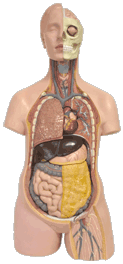At WiseGEEK, we're committed to delivering accurate, trustworthy information. Our expert-authored content is rigorously fact-checked and sourced from credible authorities. Discover how we uphold the highest standards in providing you with reliable knowledge.
What is Xenobiotic Metabolism?
Xenobiotic metabolism refers to the various chemical reactions, called metabolic pathways, that a living organism uses to alter chemicals that are not normally found in an organism as part of its natural biochemistry. These chemicals, called xenobiotics, can include things such as poisons, drugs, and environmental pollutants. Xenobiotic metabolism is important for life, as it allows an organism to neutralize and eliminate foreign toxins that would otherwise interfere with the chemical processes that keep it alive. The xenobiotic metabolism of humans and many other forms of life is important in fields such as medicine, agriculture, and environmental science.
Many potentially harmful substances are prevented from doing damage by the membranes of cells, which regulate which chemicals are allowed to enter a cell and physically block many xenobiotics. Polar molecules, which have electric dipoles because their electrons are not evenly shared among the molecule's atoms, are generally unable to get past a cell's membrane. Nonpolar molecules, however, can pass through the permeable membrane and into the cell. Xenobiotic metabolism protects the body from these substances with enzymes that will react with most nonpolar compounds. This specialization prevents them from attacking helpful substances that are part of the organism's normal biochemistry, which are polar compounds able to diffuse through cellular membranes with the aid of transport proteins.

In the first stage of xenobiotic metabolism, the foreign substance is modified through chemical reactions that add polar or reactive groups to its molecules. This is most commonly done with enzymes that catalyze monooxygenase reactions with oxygen molecules, or O2, and hydrogen, adding one atom of oxygen from the O2 to the xenobiotic molecule and producing a molecule of water as a byproduct. The most prominent group of proteins involved in this stage is the cytochrome P450 family, which encompasses more than 11,500 different proteins and is present in all forms of life on Earth.
The modified xenobiotic is then detoxified through reactions with other molecules, combining with them to form molecules called xenobiotic conjugates. Chemicals commonly used in this phase include glycine (C2H5NO2), glutathione (C10H17N3O6S), and glucuronic acid (C6H10O7). These molecules are anionic, meaning that they contain more electrons than protons and so have a negative electrical charge. Depending on the substance involved, the resulting conjugates may undergo further chemical reactions in the course of detoxification.
Finally, the conjugate is excreted from the cell. Its negatively charged anionic groups allow it to bind with protein transporter molecules, which carry the conjugate across the cellular membrane and out of the cell. From there the xenobiotic may be further metabolized by extracellular biochemicals or expelled from the body entirely in sweat, urine, or feces.
Over time, the xenobiotic metabolism of succeeding generations of organisms can evolve to give greater protection against substances they are likely to encounter in their environment, as the members of the species best able to handle them outlive and out-breed their fellows. This allows many forms of life to live in environments or safely eat food that would be deadly to other species. This can in turn spur evolution in species that produce toxins for hunting or defensive purposes, creating selective pressure that favors organisms most effective at overcoming the metabolism of their predators or prey.
Xenobiotic metabolism is an important factor in agriculture. The reaction of different organisms to xenobiotics affects how they will be affected by agricultural chemicals such as pesticides. This makes evolutionary adaptation to xenobiotics a major concern, as pests such as crop-eating insects can evolve greater resistance to pesticides as less resistant members of a species are winnowed out of the gene pool.
Xenobiotic metabolism is also important in medicine, as most drugs are xenobiotics. Some drugs have no medical effect in the form that is actually administered to the patient and become active when they are chemically altered by the patient's metabolism, a process called bioactivation. This is most commonly done by oxidizing the drug's molecules and usually involves the cytochrome P450 family. However, it can also involve other proteins such as epoxide hydrolase, methyltransferase, and n-acetyltransferase, which cause chemical changes such as hydrolysis, methylation, and acetylation, respectively. One common cause of dangerous drug interactions is when one drug has an effect on the patient's metabolism that interferes with the body's ability to metabolize another drug, allowing the latter to accumulate unprocessed until it reaches dangerous levels and poisons the patient.
AS FEATURED ON:
AS FEATURED ON:










Discuss this Article
Post your comments